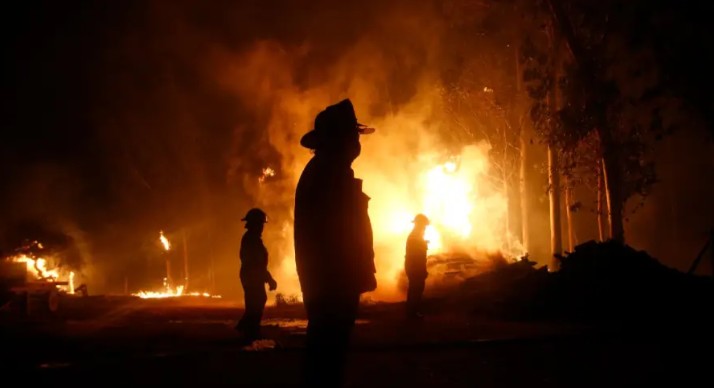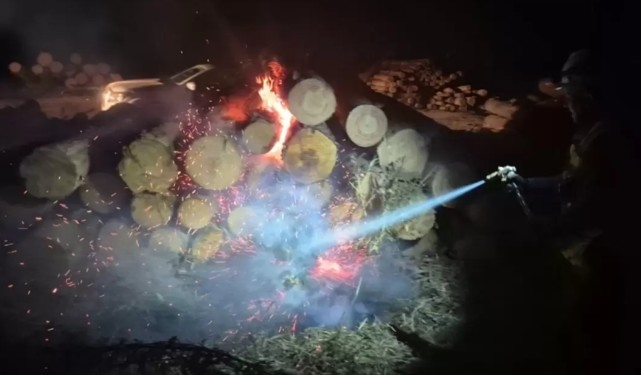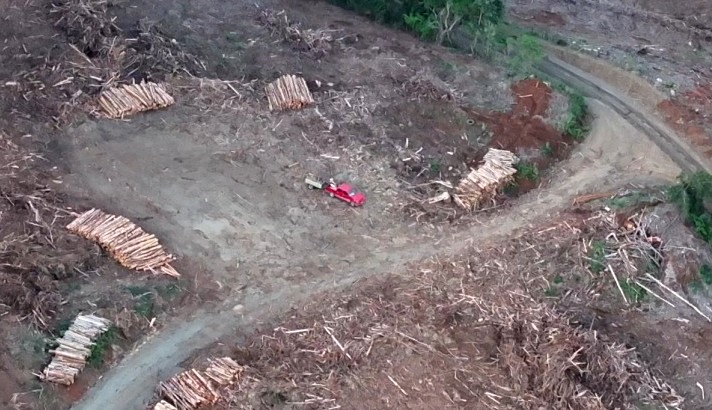Ñuble defines its first roadmap to tackle heatwaves, droughts, and fires
Strengthening the adaptive capacity of the Ñuble region in the face of extreme events associated with climate change and reducing greenhouse gas emissions is the goal of the future Regional Climate Change Action Plan (PARCC).
The draft was approved last September by the regional government and is currently in stage III of citizen consultation, which adds to other participatory instances developed during its preparation, where municipalities were involved alongside various public services, as well as the private sector and representatives of civil society.
The document presents a regional climate diagnosis, its vulnerabilities, types of emissions, and actions to achieve formal approval of the definitive PARCC.
The draft contains 16 strategic measures for adaptation, mitigation, and integration, which will be developed by the ministries of Environment; Energy; Transport; Public Works and Housing and Urban Planning, in addition to services such as Infor, Indap, Conaf, Senapred, Undersecretariat of Fisheries, Sernatur, and DGA.
The proposal is available at www.goredenuble.cl and can be commented on online. Additionally, a paper copy has been made available for submitting observations at the Regional Government.
The citizen consultation closes on November 10, and stage 4 begins, corresponding to the development of the definitive project, which must incorporate viable and relevant observations. Following this, it must be approved by the Ñuble Regional Climate Change Committee (CORECC).
Stage 5 corresponds to the final approval of the document that will be the regional climate management instrument, to be implemented over five years. Its actions must align with the Ñuble 2030 Regional Development Strategy and the Framework Law on Climate Change.
The financing of the Ñuble PARCC is subject to the sectoral budgets of the various public services that are part of CORECC, as well as some initiatives that already have competitive fund financing and/or will be submitted for funding.
Rising maximum temperature
The text revealed climate background of the region, such as the constant increase in the daily maximum temperature. In Chillán, 214 heatwaves have been identified since 1970. The longest occurred in 1997 for 9 days, with an average temperature of 28.2°C and a maximum of 30.2°C. The hottest heatwave was in 2019, lasting 4 days, with an average of 37.7°C and a maximum of 40°C.
Analysis of historical data reveals irregular behavior in precipitation, because although a decrease in rainfall over time has been observed, intense events have occurred. The mountain range records the highest annual average (Caracol station 2,347 mm, Diguillín station 1,961 mm), while in the central zone, including Chillán, the average is 1,006 mm. In coastal areas, precipitation is lower than in the rest of the region (Coelemu station 841.5 mm). However, between June and August 2023, significant events were recorded, with consequences such as interrupted routes, isolated people, and families without electricity supply. The monthly accumulated precipitation in Chillán showed a surplus of 7% compared to previous years.
According to the document, the variation in the regional annual mean temperature is calculated at an average of +1.28°C, with a notable increase of up to 1.5°C in eastern and southeastern areas, which would experience greater impacts.
In the Ñuble region, a significant increase in the frequency of heatwaves is projected, especially in San Nicolás, Chillán, San Carlos, and Ñiquén, which would exceed 20 consecutive days of heatwaves under the future scenario. Regarding the mountain communes including Coihueco, San Fabián, and Pinto, they will show a smaller increase. Ñiquén will show a significant variation, going from 19 days to 40 days of heatwaves in the future. On the other hand, for the autumn season (March, April, May), the commune of San Nicolás will experience a greater increase in consecutive days above 30°C, followed by Ñiquén and Chillán.
Declining rainfall
An average decrease of 16.42% in precipitation is projected, accentuated in the north of the region. A general decrease is expected in all communes, moving from a current annual average of 1226.18 mm to 1025.91 mm in the projected scenario, with the communes of San Nicolás, Portezuelo, Chillán, and Chillán Viejo being the most affected.
According to climate projections, San Fabián will experience a significant decrease, between -2.67% and -0.72%, in maximum daily rainfall.
A 20% increase in the frequency of droughts is projected at the regional level for the period 2035-2065. The change varies from 16% in the communes of Coelemu, Yungay, and Pemuco, to 23% in the communes of Coihueco, San Fabián, San Nicolás, Ñiquén, and Chillán, which would be the most affected by water deficit.
Snow decrease will occur in the eastern part of the region, affecting communes with mountain areas, with losses ranging between -46.20% and -96%. El Carmen (-95.58%), Pemuco (-87.21%), and Yungay (-81.25%) will record a drastic drop. A 100% decrease in summer snowfall is evident in Pinto, while in autumn, winter, and spring, strong reductions are anticipated, mainly affecting San Fabián, Pinto, and San Nicolás.
Impacts of climate change in the region
The temperature increase in the region has been recorded on average as 2°C during winter and 5°C in summer, and this trend is expected to continue rising in the next 30 years.
This situation has led to significant changes. The Nevados del Chillán volcanic complex has experienced a concerning decrease in the extent of its 26 glaciers. A 2014 study by the University of Chile indicated a glacial retreat of 63.6% between 1978 and 2011, linked to rising temperatures, estimating an increase of 0.27°C in the average annual temperature per decade.
Over the last decade, glacial retreat has persisted with a reduction of 56.6% between 2014 and 2022, recording a glacial area of 2.63 km² in the last year according to the Public Glacier Inventory.
The vulnerability study on Chile's coasts highlights that 0.26% of the total area of the region, equivalent to 34 km², is exposed to risks due to increased wave action and rising flood levels. In terms of vulnerability, a 0.3-meter increase in flood level could affect approximately 90 elements in Cobquecura and 48 in Coelemu.
Increasing temperatures and decreasing precipitation can have a significant impact on the distribution of the huemul. These climate changes could affect the availability of vegetation in its habitat.
In flora, endemic species like the queule could decrease their presence. It was projected that variations in evapotranspiration, precipitation, temperature, and daily solar insolation would generate variations in the species' probability of presence by about -30% in the region.
Climate change negatively affects the productivity of oak, raulí, and coihue forests in the Ñuble region, with an estimated reduction of 358,760 m³ accumulated by 2050 and 615,017 m³ by 2070.
Forest fires also impact native forest cover. Although most have anthropogenic origins, climate change will favor environmental conditions conducive to the intensification and rapid spread of fires, as a result of increased winds and droughts, conditions that according to the climate risk atlas, will present more intense increases in Ñiquén, Chillán, Chillán Viejo, and Bulnes.
Impacts on communities
The region faces a severe drought, exacerbated by decreasing precipitation and rising temperatures. Since 2016, water scarcity has affected urban and rural communities, causing the evaporation of water bodies and the reduction of wells.
Likewise, the risk of flooding due to torrential rains has been assessed, highlighting an increase in probabilities in urban areas like San Carlos and Chillán, especially in the foothills, which has caused significant losses. This was evidenced in August 2023, when intense rains affected over 420 homes and left more than 300 people affected in Ñuble.
Cobquecura and Coelemu are at moderate to high risk, with threats associated with rising flood levels. Between June and August 2023, storm surges caused notable impacts, with abnormal waves of 5 to 6 meters affecting homes in Vegas de Itata.
Forest fires have significant impacts on the communities of the region, recording physical damage to homes, material goods, and livelihoods; additionally, they alter air quality directly affecting people's health. In February 2023, intense fires were recorded with 69,478 ha burned, 339 homes destroyed, and 902 people affected, leading to the declaration of a State of Exception.
Impact on economic activities
Rising temperatures affect flow increase patterns and farmers, forcing adjustments in planting and harvesting times. Temperatures favor the spread of plant diseases affecting crops and resulting in significant economic losses.
The forestry industry has experienced a notable increase in Chillán, Pinto, Bulnes, and San Ignacio. This change has led to a decrease in native forests, generating risks such as soil erosion and the frequency of forest fires, especially in summer. In the 2023 forest fires, it was identified that 3.6% of the regional plantation area, equivalent to 32,664.69 ha, was affected.
Forest fires have affected tourism in the region, with the closure of the Los Huemules del Niblinto and Ñuble reserves, resulting in a decrease in visitors and economic income.
The heavy rains that occurred in June 2023 affected small and medium-sized tourism businesses, causing damage to infrastructure and affecting communes like Cobquecura and San Fabián. Also, the Nevados de Chillán tourist complex suffered impacts during the winter season due to the projected retreat of the maximum snow level by 2050.
Action Plan
Through the future Regional Climate Change Action Plan, the aim is to confront extreme events associated with climate change and reduce greenhouse gas emissions from the main emitting sectors in the region, such as energy and agriculture.
Among some of the actions, to mention a few, are strengthening the Forest Fire Protection Program, as well as inspection and monitoring to reduce their conditions. Additionally, it aims to promote the use of renewable and efficient energy and sustainable mobility. It also seeks to promote tools for afforestation and deforestation of lands affected by fires, promotion of sustainable development for the forestry and agricultural sector, oversight of land planning regulations, improvement of coastal and riverbank defenses, investment programs to ensure optimization of water use for the agricultural and livestock sector, ecological restoration of ecosystems, among others.
The regional governor, Óscar Crisóstomo, indicated that this work is a strategic roadmap to secure the future of Ñuble.
"It provides us with the tools to manage our water resources much more efficiently, protect our small-scale family farming, and better prepare our 21 communes for risks such as drought or fires," he explained.
The authority highlighted that the draft of the Regional Action Plan was carried out with a decentralized vision and connected with the needs of the people of Ñuble.
"Ñuble has shown that decentralization is also climatic: from the territory, real solutions can be generated to the effects of climate change across the entire region. As the Regional Government, we are committed to leading this adaptation. The PARCC is the foundation upon which we will build a safer, more sustainable Ñuble, prepared for the challenges of tomorrow, guaranteeing a better quality of life for current and future generations," he emphasized.
Civil society assessment
The NGO Unidos por la Acción is part of the Regional Climate Change Committee, where they seek to contribute with a comprehensive and territorial perspective, focused on health. The organization has experience in community education, emergency management, animal protection, and eco-community restoration.
Among their contributions in this instance, they have warned that work must be done on the weak preparation for climate emergencies (fires, droughts, floods) that affect families and animals, as well as the need to include animals and biodiversity in climate planning, because they are part of the social, economic, and ecological fabric of Ñuble.
For the organization's representative, Andrea Burgos, the draft "is heading in the right direction," however, she warned that key elements for inclusive and effective adaptation are missing.
"It is necessary to reinforce protocols for climate emergencies with an animal and community focus, local multi-species evacuation and shelter plans, support for rural families, small producers, and wildlife. Additionally, permanent community education and participation and greater coordination between institutions, academia, and territorial organizations. In short, Chile is progressing, but it still needs to ensure that in planning, no one is left out; neither people, nor animals, nor the ecosystems that sustain life and regional development," she stated.
From the NGO Oxum, dedicated to water education, agri-food, and community development, they valued that the measures proposed in the new plan respond to the challenges of climate change, although they warned that this work should have been done earlier.
"I feel there is an awareness that we must move forward. (...) But we are behind, because it is the first proposal and it will have a lot to correct. The role this plan is fulfilling is somewhat to put the house in order. This is a plan that is also pushing the different services, because they also have to be, in quotes, pressured to be able to talk among themselves, which has been very difficult in Chile. In that sense, having an instrument that sets the rules a bit is very positive," expressed the president of Oxum, Fernando Villegas.
Likewise, they emphasized the importance of rural planning being articulated with the development of the territories and adapted to community dynamics, avoiding conflicts derived from unregulated land subdivision processes that, they stated, are altering productive ecosystems, generating pollution, and affecting coexistence between traditional inhabitants and new residents.
"Territories understood from the communities, a development that is much more integral. It's not about waging a war against big industry, but about taking into account the ways of life of the communities and that they are also capable of making decisions, that their production methods are considered and from there transition to other ways of life that are less harmful to the environment. The problem is that there are areas that are very good for production and are being subdivided to build vacation homes, and that brings a tremendous problem," he stated.
Source:La Discusión

















